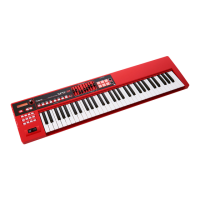Other Settings
32
Menu
[SHIFT] + CURSOR [
K
] [
J
]
Parameter
CURSOR [
K
] [
J
]
Value
VALUE [-] [+]
Explanation
PEDAL
Asgn (Assign)
MODULATION,
PORTA-TIME,
VOLUME, PAN,
EXPRESSION,
HOLD,
PORTAMENTO,
SOSTENUTO,
RESONANCE,
RELEAS-TIME,
ATTACK-TIME,
CUTOFF,
DECAY-TIME,
VIB-RATE,
VIB-DEPTH,
VIB-DELAY,
CHORUS-SEND,
REVERB-SEND,
AFTERTOUCH,
START/STOP,
TAP-TEMPO,
PROG-UP,
PROG-DOWN,
FAV-UP,
FAV-DOWN
The pedal connected to the PEDAL jack can control the following functions.
The number in parentheses ( ) is the controller number of the control change message produced by the
pedal when the corresponding function is assigned.
* Regarding the following functions, the eect will apply to the currently selected sound if you’re playing
a single sound. If you’re using settings that play multiple tones (i.e., if the [PERFORM] button is lit), this
will apply to the tone (part) you’re playing.
MODULATION: (CC01) Vibrato
PORTA-TIME: (CC05) Portamento time
VOLUME: (CC07) Level
PAN: (CC10) Pan (left/right position of the tone)
EXPRESSION: (CC11) Level
HOLD: (CC64) The sound will be sustained for keys that are played or were already held
down while holding down the pedal.
PORTAMENTO: (CC65) Portamento switch
SOSTENUTO: (CC66) The sound will be sustained only for keys that were already pressed when
you pressed the pedal.
RESONANCE: (CC71) Resonance (p. 19)
RELEASE-TIME: (CC72) Release time (p. 19)
ATTACK-TIME: (CC73) Attack time (p. 19)
CUTOFF: (CC74) Cuto (p. 19)
DECAY-TIME: (CC75) Decay time
VIB-RATE: (CC76) Vibrato speed
VIB-DEPTH: (CC77) Vibrato depth
VIB-DELAY: (CC78) Vibrato delay time
CHORUS-SEND: (CC93) The amount of the chorus
REVERB-SEND: (CC91) The amount of the reverb
AFTERTOUCH: Channel aftertouch
START/STOP: Pressing the pedal will start/stop the Song Player or Rhythm Pattern (p. 28).
TAP-TEMPO: The tempo will be set to the interval at which you press the pedal (Tap Tempo).
PROG-UP: If you’re playing a single sound, this selects the next sound. If you’re playing
multiple sounds (i.e., when the [PERFORM] button is lit), this selects the
next-numbered performance.
PROG-DOWN: If you’re playing a single sound, this selects the previous sound. If you’re playing
multiple sounds (i.e., when the [PERFORM] button is lit), this selects the
previous-numbered performance.
FAV-UP: The favorite of the next number or bank will be selected.
FAV-DOWN: The favorite of the previous number or bank will be selected.
Cont Hold
(Continuous Hold)
OFF, ON
If “Assign” is set to “HOLD,” turning this “ON” allows the PEDAL jack to support half-pedaling.
When this is set to support use of half-pedaling techniques, you can then connect an optional damper
pedal (DP series, etc.), and employ pedal work to achieve even ner control in performances in which piano
tones are used.
Polarity
STD (STANDARD),
RVS (REVERSE)
Selects the polarity of the pedal connected to the PEDAL jack.
On some pedals, the electrical signal output by the pedal when it is pressed or released is the opposite of
other pedals. If your pedal has an eect opposite of what you expect, set this parameter to “REVERSE.” If you
are using a Roland pedal (that has no polarity switch), set this parameter to “STANDARD.”
MIDI
Local Switch OFF, ON
Determines whether the internal sound generator is disconnected (OFF) from the controller section
(keyboard, pitch bend/modulation lever, buttons, sliders, pedal, and so on); or not disconnected (ON).
Normally you’ll leave this “ON.” Choose the “OFF” setting if you want operations on the XPS-10 to only
control DAW software on your computer.
Patch Rx/Tx Ch 1–16 In patch mode, species the MIDI message transmit/receive channel for the keyboard part.
Tx Edit Data OFF, ON
Species whether changes you make in the settings of a tone, performance will be transmitted as system
exclusive messages (ON), or will not be transmitted (OFF).
Sync Mode MASTER, SLAVE
Species the synchronization message that the XPS-10 will use for operation.
MASTER: The XPS-10 will be the master. Choose this setting when using the XPS-10 by itself without
synchronizing to another device.
SLAVE: The XPS-10 will be the slave. Choose this setting when you want the XPS-10 to synchronize to
MIDI Clock messages received from another MIDI device.
USB Drv
(USB Driver)
GENERIC, VENDER
Sets the USB driver.
* This setting will take eect when you turn the power o, then on again.

